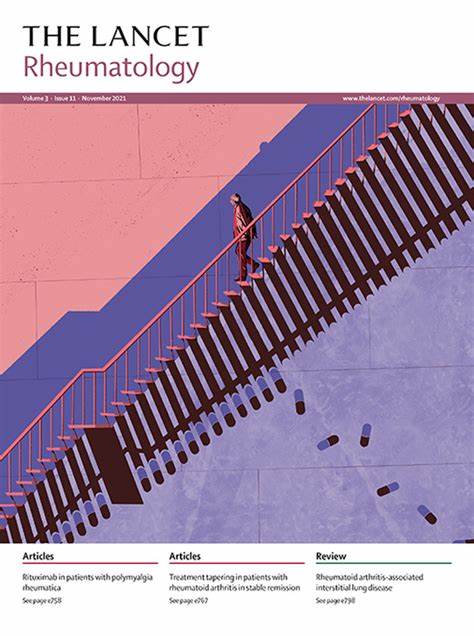暴露于免疫检查点抑制剂后关节痛或炎症性关节炎患者的全身MRI:一项单中心前瞻性成像研究
IF 16.4
1区 医学
Q1 RHEUMATOLOGY
引用次数: 0
摘要
背景:免疫检查点抑制剂引起的肌肉骨骼不良事件很常见,在临床上表现为炎症性关节炎、风湿性多肌痛或关节痛。与免疫检查点抑制剂相关的肌肉骨骼不良事件的病理解剖仍然不明确,缺乏可用的成像数据。我们的目的是研究暴露于免疫检查点抑制剂后关节痛和炎症性关节炎的全身成像表型,以充分表征这些患者的炎症模式,并随后告知临床管理。方法:在这项前瞻性影像学研究中,在英国利兹的Chapel Allerton医院的利兹风湿病科招募了年龄在18岁或以上的患者,这些患者在接受免疫检查点抑制剂治疗期间或6个月内开始出现新的肌肉骨骼症状,并与年龄在18岁或以上的健康对照者进行对照,这些患者没有风湿病自身免疫性疾病的个人病史,没有活动性癌症,在MRI扫描日期前4周内没有自我报告的关节疼痛。并接受了钆增强全身MRI检查。关节、肌腱、法氏囊、骨骺和整个脊柱影像学病变由两个独立的匿名评估者分级并达成共识。分析炎症性全身MRI模式,随访6个月。有炎症性关节炎和与免疫检查点抑制剂相关的肌肉骨骼毒性生活经验的人强调了了解和理解成像结果的重要性,以帮助告知免疫抑制治疗的风险与收益决策。研究结果:在2021年10月20日至2024年5月22日期间,招募了60名患者(35名[58%]关节炎患者和25名[42%]炎症性关节炎患者)和20名健康对照。患者平均年龄65岁(SD 11),健康对照组平均年龄62岁(SD 7);男性34例(57%),女性26例(43%),健康对照组男性12例(60%),女性8例(40%)。所有患者和健康对照均为白色。与健康对照组相比,免疫检查点抑制剂诱导的关节痛或炎症性关节炎患者的中位全关节滑膜炎、关节糜落、腱鞘炎和腱鞘炎评分明显更高,炎症性关节炎和关节痛亚组之间无显著差异。60例患者中肩锁关节(46例[77%])、盂肱关节(45例[75%])、腕关节(43例[73%])和掌指关节(35例[59%])是滑膜炎最常发生的关节。有三种不同的全局炎症模式:60例患者中22例(37%)为外周炎性关节炎;7例(12%)为多肌痛风湿病,12例(20%)为多肌痛风湿病和周围炎性关节炎的重叠表型。仅在一名患者中发现轴性炎症。需要改善疾病的抗风湿药物治疗的5例患者中有4例属于外周炎性关节炎组,该组初始和持续的糖皮质激素需求也最高。解释:MRI炎症和糜烂在暴露于免疫检查点抑制剂的关节痛患者中与炎症性关节炎患者一样普遍。这一发现表明,与免疫检查点抑制剂相关的肌肉骨骼毒性的总体负担目前尚未得到充分认识。暴露于免疫检查点抑制剂后发生炎性关节炎或关节痛的患者有三种主要的影像学模式:风湿性多肌痛、周围性炎性关节炎和风湿性多肌痛和炎性关节炎的重叠。外周炎性关节炎患者最可能需要治疗疾病的抗风湿药物。资助:国家卫生与保健研究所(NIHR)利兹生物医学研究中心。本文章由计算机程序翻译,如有差异,请以英文原文为准。
Whole-body MRI in patients with arthralgia or inflammatory arthritis after exposure to immune checkpoint inhibitors: a single-centre prospective imaging study
Background
Musculoskeletal adverse events due to immune checkpoint inhibitors are common and can present clinically as inflammatory arthritis, polymyalgia rheumatica, or arthralgia. The pathoanatomy of musculoskeletal adverse events related to immune checkpoint inhibitors remains undefined, with a paucity of available imaging data. We aimed to investigate the whole-body imaging phenotype of arthralgia and inflammatory arthritis following exposure to immune checkpoint inhibitors, to fully characterise the pattern of inflammation in these patients and subsequently inform clinical management.
Methods
In this prospective imaging study, patients aged 18 years or older with new musculoskeletal symptoms that started during or up to 6 months after receiving an immune checkpoint inhibitor and healthy controls aged 18 years or older, with no personal history of rheumatological autoimmune disease, no active cancer, and no self-reported joint pains in the 4 weeks before their MRI scan date, were recruited at the Leeds Rheumatology department of Chapel Allerton Hospital, Leeds, UK, and underwent gadolinium contrast-enhanced whole-body MRI. Joint, tendon, bursal, entheseal, and whole spinal imaging lesions were graded by two independent masked assessors and consensus reported. Inflammatory whole-body MRI patterns were analysed and patients were followed up for 6 months. People with lived experience of inflammatory arthritis and musculoskeletal toxicity related to immune checkpoint inhibitors highlighted the importance of knowing and understanding imaging findings to help inform risk versus benefit decisions about immunosuppressive treatments.
Findings
Between Oct 20, 2021, and May 22, 2024, 60 patients (35 [58%] with arthralgia and 25 [42%] with inflammatory arthritis) and 20 healthy controls were recruited. The mean age of patients was 65 years (SD 11) and that of healthy controls was 62 years (7); 34 (57%) patients were men and 26 (43%) were women, and 12 (60%) healthy controls were men and eight (40%) were women. All patients and healthy controls were White. Median total joint synovitis, joint erosions, enthesitis, and tenosynovitis scores were significantly higher in patients with arthralgia or inflammatory arthritis induced by immune checkpoint inhibitors compared with healthy controls, without significant differences between the inflammatory arthritis and arthralgia subgroups. Acromioclavicular (46 [77%] of 60), glenohumeral (45 [75%] of 60), wrist (43 [73%] of 59), and metacarpophalangeal (35 [59%] of 59) joints were the most frequently affected by synovitis in all patients. There were three distinct global inflammatory patterns: peripheral inflammatory arthritis in 22 (37%) of 60 patients; polymyalgia rheumatica in seven (12%), and an overlapping phenotype of polymyalgia rheumatica and peripheral inflammatory arthritis in 12 (20%). Axial inflammation was only identified in one patient. Four of the five patients requiring disease-modifying antirheumatic drug therapy were in the peripheral inflammatory arthritis group, which also had the highest initial and ongoing glucocorticoid requirement.
Interpretation
MRI inflammation and erosions are as prevalent in patients with arthralgia exposed to an immune checkpoint inhibitor as in those with inflammatory arthritis. This finding suggests that the overall burden of musculoskeletal toxicity associated with immune checkpoint inhibitors is currently under-recognised. Patients who develop inflammatory arthritis or arthralgia after exposure to immune checkpoint inhibitors have three main imaging patterns: polymyalgia rheumatica, peripheral inflammatory arthritis, and an overlap of polymyalgia rheumatica and inflammatory arthritis. Patients with peripheral inflammatory arthritis were most likely to require disease-modifying antirheumatic drugs.
Funding
The National Institute for Health and Care Research (NIHR) Leeds Biomedical Research Centre.
求助全文
通过发布文献求助,成功后即可免费获取论文全文。
去求助
来源期刊

Lancet Rheumatology
RHEUMATOLOGY-
CiteScore
34.70
自引率
3.10%
发文量
279
期刊介绍:
The Lancet Rheumatology, an independent journal, is dedicated to publishing content relevant to rheumatology specialists worldwide. It focuses on studies that advance clinical practice, challenge existing norms, and advocate for changes in health policy. The journal covers clinical research, particularly clinical trials, expert reviews, and thought-provoking commentary on the diagnosis, classification, management, and prevention of rheumatic diseases, including arthritis, musculoskeletal disorders, connective tissue diseases, and immune system disorders. Additionally, it publishes high-quality translational studies supported by robust clinical data, prioritizing those that identify potential new therapeutic targets, advance precision medicine efforts, or directly contribute to future clinical trials.
With its strong clinical orientation, The Lancet Rheumatology serves as an independent voice for the rheumatology community, advocating strongly for the enhancement of patients' lives affected by rheumatic diseases worldwide.
 求助内容:
求助内容: 应助结果提醒方式:
应助结果提醒方式:


